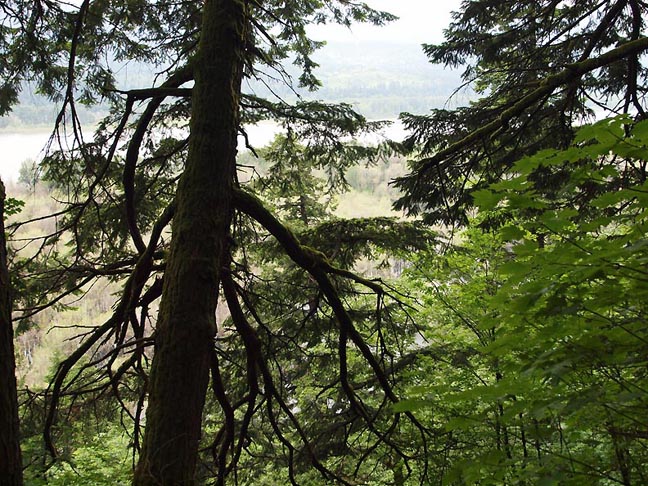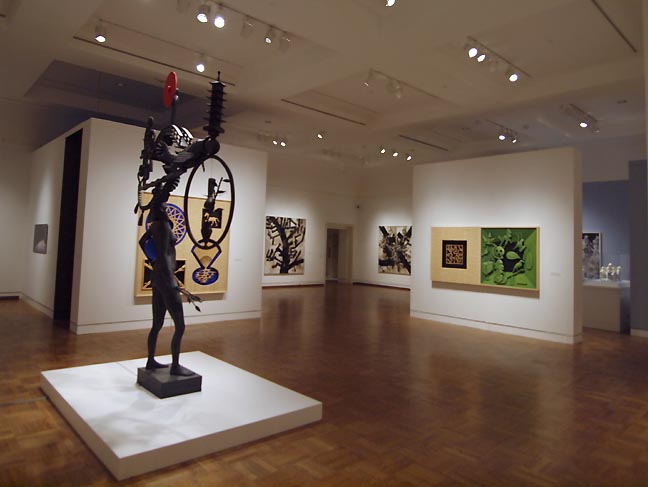
|
||
|
Portland art blog + news + exhibition reviews + galleries + contemporary northwest art
|
||
Forest for the Tree Farm (Part I)
Although the CNAA is not a biennial, per se, it is a regional event that happens every other year, and draws on art from Oregon, Washington, Idaho, Montana and Wyoming. (Tacoma Art Museum’s Biennial excludes Wyoming.) I mention this partly because I would find it slightly humorous if there were actually two different biennials for a given region. However, the fact that there are two very similar events that culminate with entirely different artists who make the cut begins to address some level of impracticality in suggesting that there may be a way to "recognize the art and artists of the region," for curatorial perspectives obviously vary, as must the mechanics behind the selection process. The key is the cull. Hushka referred to it as a connoiseurship, twice. A very small number of people decide who are noteworthy artists within the region, and within that decision making process, there might be an attempt to elucidate what one determines to be an idiosyncratic nature shared by those artists. It is wholly a curatorial process, and therefore necessarily exclusionary as to other factors that might be considered. For instance, landscape painters might be entirely disregarded when markers for a different theme are posited. The same applies to any call for a Northwest aesthetic: it is necessarily a subjective call, and to insist on mailing down such a notion may end up somewhat reductive or even positivistic. Pursuant to questions in the last portion of the discussion, Bonnie asserted that, in fact, Oregon artists are different than artists in other states in the region. One may assume that Washington artists are likewise different from artists in Montana or Idaho. This in itself speaks to the likelihood that there is not an overarching theme to Northwestern art. Yet, she went on to say that the artists do want to know what artists in neighboring states are doing. The third panel member, Beth Sellers from Suyama Space, seemed to echo this sentiment by suggesting that the multiple state format of these exhibitions opens up a dialogue among the artists in order for them to compare and contrast what is going on in the different states. If, then, there is a regionalized, predominating influence that develops from this curiosity and consequent dialogue, it might very well be the same type of influence that an a'tist derives from an art magazine or by perusing other artists' websites from any and everywhere. Trends do happen. Yet, there is an 800-pound guerilla that must be addressed: Northwest artists are surrounded by Nature's 'majesty'. We gaze upon it, relatively speechless and barely aware that our presence has a contingency. (Nature in and of itself eludes meaning yet inspires, and this, I might suggest, is also why we find so much abstract art in the Northwest, but I will eave this for discussion at a later time). It presents a context regardless of whether we choose to embrace or displace its influence; and we recognize it in everything from landscape paintings and photographs to the construction at Terwilliger Curve or the long line of earth-moving equipment just north of Wilsonville on I-5.
Finally, this might be why there was an initial promise to suss out a Northwestern, regional, aesthetic: to make more of something than what it is. Like nationalism, there is a desire for a sense of pride we share for our region, and a concomitant need to insist that there is something special about this group with whom we identify. We feel safe, chosen, even if in our hearts we know it is illusory. It is also variously known as boosterism, and it sells. No doubt all three panelists are acutely aware of this and that is perhaps the reason the panel discussion felt more like an apologia for what was marketed as one thing yet ended up largely being about something else.
Posted by Patrick Collier on July 21, 2011 at 12:32 | Comments (1) Comments Would like to respond more in depth and less in fragment. But, time.... that excuse. I speak from the perspective of a regional artist with a family history in the NW dating back 4 generations; many of us were and still are artists, mountaineers, ecologists, conservationists and political activists. In my opinion you see more derivative works in areas of greater competition. To see any signs of an over-arching NW theme, you must give a fair look into some of the more remote areas and smaller metropolises. The point made in this section; "Historical surveys may be where a curator might have better luck determining a regional aesthetic," is spot on. There's a great history surrounding relationships between NW artists. I've had conversations w/ veteran NW artists and curators who talk of days when they'd travel to Oregon, Washington, Idaho and Montana routinely in support of colleagues and to establish relationships with new talent. Imagine that… The NW is unique, we even have our own primate. Not to mention one of the most complex native art styles in the world. We're also more than capable of producing stand-out, big name artists of all kinds and genres. Our visual and performing artists portfolio is fucking stunning. Most interesting is the mention of the "800-pound guerilla." Artists I know who have long histories here, embrace the closeness they feel with nature through their work. It's an idea that (through my own experiences) is hard for people to talk honestly about. Why? Maybe because for some discussing nature parallels with discussing god, or spirituality. There are serious faux pas' surrounding the idea of god or spirituality in art. It's taboo! You start inserting your spiritual beliefs in an artist statement and immediately you loose, about everyone. Regardless, nature is the NW. We're steeped in it historically, metaphorically, socially, culturally and politically. Why not artistically? Look [there] and you'll find the answers to all the ambiguities. I've watched my work develop through many stages and there is always some formal lesson I've learned from being aware of my natural surroundings. It's great to have writers this dedicated to an area. A blog like this in NY would have 20+ comments. Thanks for your hard work and sincerity… Posted by: Garric Simonsen Post a comment Thanks for signing in, . Now you can comment. (sign out)
(If you haven't left a comment here before, you may need to be approved by
the site owner before your comment will appear. Until then, it won't appear
on the entry. Thanks for waiting.)
|
| s p o n s o r s |
 |
 |
 |
 |
 |
 |
 |
 |
 |
 |
 |
 |
 |
 |
 |
 |

|
Site Design: Jennifer Armbrust | • | Site Development: Philippe Blanc & Katherine Bovee | |




![[TypeKey Profile Page]](http://www.portlandart.net/nav-commenters.gif)